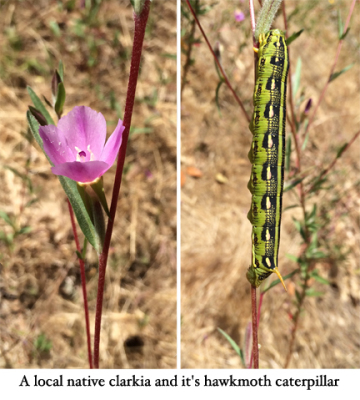Santa Cruz County Weed Management Area
It's not about weeds, it's about local ecosystems

Native lupine and owl's clover wildflowers
The Santa Cruz County WMA is a newly reformed collaborative project to combat the destructive effects of non-native invasive plants on our wildlands, parks, and farms.
Land Managers from public and non-profit agencies and volunteers meet to share information and strategies for
invasive plant control. Meetings are held quarterly on the second Tuesday of the month starting in January of each year.
To be added to our mailing list, send an email to:
wmaofsantacruzcounty@gmail.com
What are invasive plants?
A non-native plant is considered invasive when it spreads to a degree that it decreases the biodiversity of a site, especially a wildland. Invasive plants can also change water and fire regimes (for the worse) and be agricultural pests.
A non-native plant is considered invasive when it spreads to a degree that it decreases the biodiversity of a site, especially a wildland. Invasive plants can also change water and fire regimes (for the worse) and be agricultural pests.
Why is a habitat that is biodiverse so important?
Native plants are the bottom of the food chain for ALL native wildlife. They provide food and structure in ways that non-native plants can’t. Native insects and plants have co-evolved and have mutual dependancies that are vital to their survival. Many insects cannot eat non-natives and insects that eat plants make up a large part of the diet of birds and other species. They (and other herbivores like woodrats and deer) move the energy plants create up the food chain to avian and mammal predators.
Instead of a few invasive over-represented species, native plant habitats have hundreds of plant species. Native annual plants have different configurations every year; certain species excel on some years, and small patches move around. This makes walking the same path year after year always a new and interesting experience. Compare an intact native plant ecosystem with open space that is degraded by invasive non-native plants to see the difference in species richness at multiple scales.
Why do invasive plants out-compete native plants?
Since invasive non-native plants don’t have as many natural predators (herbivores) they have a competitive advantage over native plants. See image below
Invasive plants also have “weedy” characteristics that help them colonize large areas quickly. This is especially true where nutrients are inadvertently added to the soil, such as farm runoff. Natives often excel in areas where nutrients are low and aren’t always equipped to exploit the extra nutrients as well as invasives can. Another weedy characteristic is the ability to create copious amounts of seed that also have long term survival in the seed bank.
How You Can Help In Your Community
1) If you live near a wildland, even a small riparian area (creek) be responsible for what may escape from your yard. Some non-native plants will not act weedy, but if you plant an invasive plant, it will spread. They spread by water, wind, critters, and people walking.
2) Volunteer to help local groups, such as ours, in combating invasive plants. Volunteers are needed for weeding, fundraising, grant writing, plant identification, monitoring and education.
3) Donate to local groups working to protect our local ecosystems.
Invasive weeds are not easy to control. Our wildlands can’t be protected by a small group of dedicated people. This is a low tech, high labor venture that needs community support. It is a problem often created by human activity. Controlling invasive plants in your community is a way to give back to nature and undo damage.
Online resources to help you identify and manage invasive plants
Invasive Species ID cards: photos & descriptions if you know the name of the plant
www.cal-ipc.org/solutions/management/edrr/species-id-cards/
UC Extension: Common Weeds in Santa Cruz County
UC Masters have volunteers to answer questions
Non-regulatory agency with free programs for land owners
How to identify and manage some of our county’s worst weeds
A Plague of Plants by Wildlands Restoration Team
Weed Workers Handbook
For gardeners: what plants are native to your area, which ones do you want, where to buy them and how to grow them
calscape.org
Cal-IPC Oct. 2017 Glyphosate Fact Sheet & Position Paper
UC Integrated Pest Management Program
http://ipm.ucanr.edu
Other local groups combating invasive plants
Watsonville Wetlands Watch
Coastal Watershed Council River Health Days
